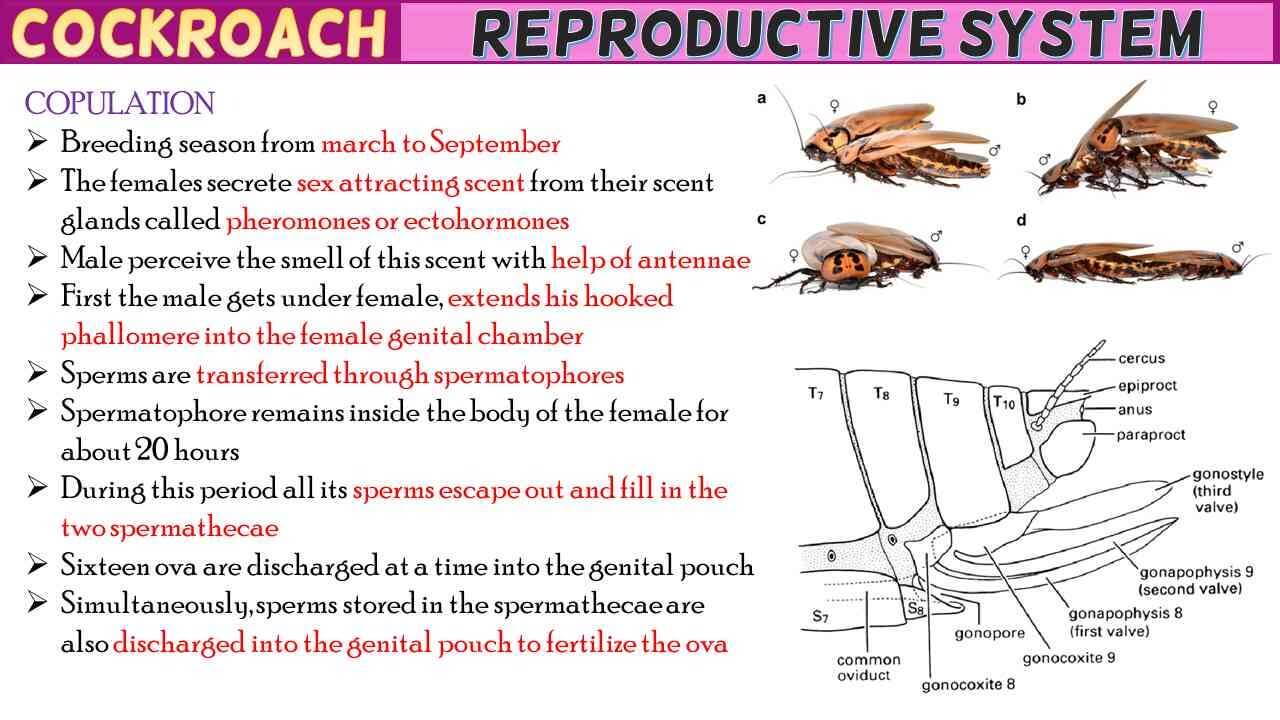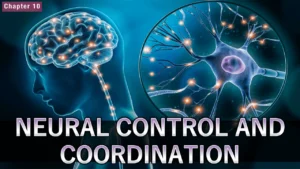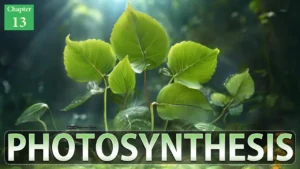Table of Contents
Cockroach Reproductive System Short Notes
In this article we will discuss about the cockroach reproductive system
Cockroach Reproductive system
- All characters of sexual dimorphism in cockroach present in abdomen
- In male, in addition of anal cerci, 9th sternum bears anal style (unjointed thread like) which are absent in females
- Cockroach are sexual dimorphism. Male and female are separate.
Male Cockroach Reproductive System
- The male cockroach reproductive system of cockroach consists of a pair of testes, vasa deferentia, an ejaculatory duct, utricular gland, phallic gland and external genitalia
Testes
- A pair of three lobed testis located on lateral side in 4-6 abdominal segments
- Testis produces sperms
- Testes become non functional in old adults
Vasa deferentia
- From each testis arises a thin thread-like tube is called vasa deferens
- Both the vasa deferentia meet in the middle and open into an ejaculatory duct
Ejaculatory duct
- Ejaculatory duct is an elongated wide duct
- Opens out by male gonopore situated ventral to the anus
Mushroom gland or utricular
- Large accessory reproductive gland
- Mushroom gland is present in the 6th and 7th abdominal segments of male cockroach
- Located at the junction of vasa deferentia with the ejaculatory duct
- It has a three types of glandular tubules
- Utriculi majores: peripheral long tubules
- Utriculi breviores: small short central tubules
- Seminal vesicles: behind the short central tubules are some short but more bulbous tubules filled with sperms
- Function of these gland is forms inner layer of spermatophore and nourishment to the sperms
Phallic or conglobate gland
- Long and club-shaped accessory gland
- Phallic duct open by a separate aperture
- Involved in the formation of the spermatophore
External genitalia
- Surrounding the male genital pore in the genital pouch there are three chitinous plates called phallomeres
- The phallomeres together constitute the phallic organs or gonapophyses
- These organ help for copulation
Spermatophore
- Sperm produced in testes are stored in seminal vesicle
- All sperms released from seminal vesicles glued together to form a ball called sperm ball
- Long tubules of mushroom gland secrete a membrane around sperm ball called spermatophore
- Small tubules secrete a nutritive fluid in spermatophore
- At the time of copulation spermatophore enters into ejaculatory duct
- Ejaculatory duct secrete another coat on spermatophore and hence it becomes double layered
- When it is released outside from male genital pore then phallic gland secretes another layer, so spermatophore becomes three layered
- They are finally discharged during copulation
Female Cockroach Reproductive System
Ovaries
- One pair of ovaries are situated in 2nd to 6th segments
- Each ovary consists of 8 blind ovarian tubules or ovarioles
- Inside ovarioles series of ova are situated in an acropetal order
Oviducts
- Ovarioles of ovary unite to form short and wide lateral oviduct
- Two lateral oviducts join to form a median common oviduct or vagina in the 7th segment
Vagina
- Posterior wider part of the common oviduct
- Vagina opens into a large genital pouch by female genital pore on the 8th sternum
Genital pouch
- Genital pouch is formed by the 7th, 8th and 9th sternites
- Genital pouch can be divided into two parts
- Genital chamber: anterior part containing female gonopore and pores of spermathecae and collateral glands
- Vestibulum: larger posterior part in which ootheca is formed
Collaterial glands
- A pair of branched accessory reproductive gland
- These glands open into the genital pouch by two separate openings
- The secretion of collateral glands helps in the formation of ootheca
Spermathecae
- A pair of unequal sized spermatheca are associated with genital chamber
- Spermathecae opens into the genital chamber on a small spermathecal papilla
- Responsible for receiving, maintaining, and releasing sperm to fertilize eggs
External genitalia of female
- Situated between the female genital pore and anus inside the genital pouch there are 3 pairs of chitinous plate like structures called gonapophyses or pallomeres
- These gonapophyses help in copulation, egg-laying and in the formation of ootheca.
Copulation
- Breeding season from march to september
- The females secrete sex attracting scent from their scent glands called pheromones or ectohormones
- Male perceive the smell of this scent with help of antennae
- First the male gets under female, extends his hooked phallomere into the female genital chamber
- Sperms are transferred through spermatophores
- Spermatophore remains inside the body of the female for about 20 hours
- During this period all its sperms escape out and fill in the two spermathecae
- Sixteen ova are discharged at a time into the genital pouch
- Simultaneously, sperms stored in the spermathecae are also discharged into the genital pouch to fertilize the ova
Fertilization
- Fertilization is internal
- Fertilized eggs become hardened by the secretion of colleterial glands, which hardens to form an ootheca
- Ootheca is a dark reddish to blackish brown capsule
- They are dropped or glued to a suitable surface
- Development of egg takes place inside ootheca
- Development is indirect, meaning there is development through nymphal stage
- The nymphs look very much like adults, the nymph grows by moulting about 13 times to reach the adult form.
- Nymph changes into an adult in 1 year
You may also like: –
- Cockroach Morphology Short Notes
- Cockroach Digestive System Short Notes
- Cockroach Excretory System Short Notes
- Cockroach Respiratory System Short Notes
- Cockroach Nervous System Short Notes
- Cockroach Circulatory System Short Notes
- Cockroach Reproductive System Short Notes
For more detailed information about Structural Organisation in Animals, download now full study material as PDF and if you want to learn more detailed information about Structural Organisation in Animals, visit YouTube Channel.




![[PPT] The living world Class 11 Notes](https://rajusbiology.com/wp-content/uploads/2024/06/PPT-The-living-world-Class-11-Notes-300x169.webp)